A Comprehensive Exploration of Marcasites
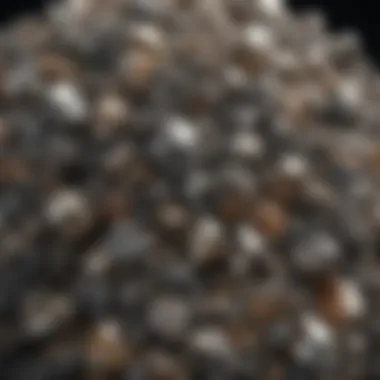
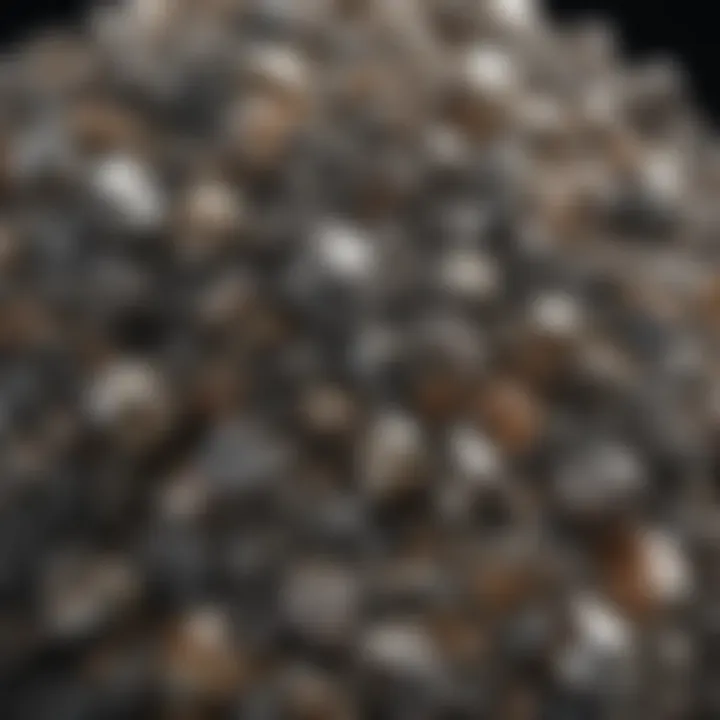
Intro
Marcasite is a mineral often overlooked, yet it has playd an essential role in geology and industry. This article seeks to demystify marcasites by providing a detailed exploration of its characteristics, formation, and various applications. Unlike pyrite, which is commonly misidentified as marcasite due to its similar appearance, marcasite has distinct features that warrant attention. This discussion is tailored for geology enthusiasts, collectors, and students who wish to deepen their understanding of this intriguing mineral.
Featured Collectible of the Month
Overview
Every month, we highlight a particular collectible to aid collectors in making informed decisions. For this article, we spotlight marcasite as a collectible item. The distinct crystallography and luster of marcasites make them desirable to many collectors. Often forming in beautiful clusters, marcasite can exhibit a range of colors from pale yellow to brownish hues. These characteristics are not only captivating but also provide insight into their geological origins.
Historical Significance
Marcasite has a rich history that dates back centuries. Used in various ancient cultures, it often served ornamental purposes. In the Victorian era, it was a favored material for jewelry. The consumption of marcasites surged as its unique characteristics were prized. Moreover, the mineral has been an important subject in geological studies, providing context and exchange in theorizing Earth's history.
Identification Techniques
Visual Characteristics
Correctly identifying marcasites is crucial for collectors and enthusiasts. Marcasites often appear lighter than pyrite. They have a distinctive metallic luster and a slightly different crystal structure, presenting as orthorhombic prisms. When observing the surfaces, look for a clear absence of oxidation typically seen in pyrite specimens. A good examination also reveals fine striations along the crystal faces.
Resources for Identification
Various resources can help in identifying marcasites effectively. Online platforms such as
- Wikipedia
- Britannica
can provide detailed articles on the mineral's properties. Additionally, engaging in communities on sites like - Reddit
and - Facebook
connects collectors and enthusiasts, fostering opportunities for learning and collaboration. An active community can be invaluable for identification and tips on care.
A knowledgeable collector observes that understanding the mineral's origins and properties enhances its appreciation.
Understanding Marcasites
Marcasites are more than just an interesting mineral; they carry significant importance in both geological studies and industrial applications. Understanding marcasites enables enthusiasts, collectors, and students to appreciate their uniqueness and relevance in various fields. This section aims to enlighten readers on the fundamental aspects of marcasites, providing a solid foundation for the specifics of their characteristics and uses.
Definition and Overview
Marcasite is a mineral composed of iron disulfide, distinguished by its unique crystal structure. Although it shares similarities with pyrite, its structural nuances and properties set it apart. Marcasite typically forms in sedimentary rocks and environments rich in sulfide minerals. It appears in various forms, including nodules and massive aggregates.
Its system of crystallization can be classified as orthorhombic. Marcasite's chemical formula is FeS2, indicating it is an iron sulfide. Understanding this definition is crucial as it lays the groundwork for recognizing both its natural occurrence and synthetic interpretations. The mineral's properties, as well as its applications, can be better explored once foundational knowledge is established.
Differences Between Marcasite and Pyrite
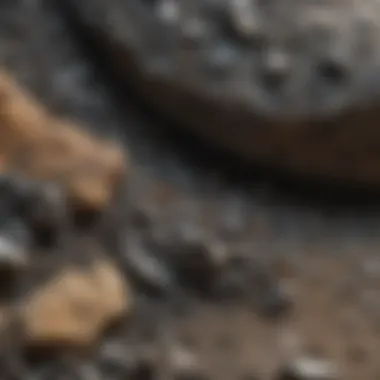

Marcasite and pyrite, often confused due to their similar appearances, hold significant differences that are worth noting.
- Chemical Composition: Both are iron sulfides, but while marcasite’s formula is FeS2, pyrite often refers to the cubic form of the same mineral. Pyrite can also be denser and tends to oxidize differently than marcasite.
- Crystal Structure: Marcasite typically has an orthorhombic crystal system, leading to its characteristic shape, which is quite different from pyrite's cubic system.
- Visual Appearance: Marcasite usually exhibits a more brittle texture and is lighter in color, whereas pyrite often has a shiny, golden hue. This makes identification essential for collectors and geologists alike.
The ability to distinguish between marcasite and pyrite is vital for any geological study or collection, as misidentification can lead to misconceptions about mineral properties and value.
The understanding of marcasites, especially their distinguishing characteristics, enhances the comprehension of their role in geology and their applications. This foundational knowledge serves as a stepping stone for further exploration into their physical characteristics and geological formations.
Physical Characteristics of Marcasites
Understanding the physical characteristics of marcasites is vital for anyone delving into this interesting mineral. These features not only serve as a basis for identification but also influence their applications in various fields, including geology and jewelry. Marcasite's unique physical traits make it distinguishable from other minerals, particularly pyrite, which often confuses many collectors and enthusiasts. Thus, focusing on its crystal structure, color, and hardness provides essential insights into its nature and use.
Crystal Structure and Morphology
Marcasite has a distinctive crystal structure that sets it apart. It commonly occurs in a tabular form, often resembling small, flattened crystals. It belongs to the orthorhombic crystal system, where the symmetry operations give rise to its characteristic shapes. The crystals can appear as needle-like or columnar forms as well, which is quite common in aggregated forms.
This unique morphology influences its applications and aesthetics. In geological terms, marcasite's crystal structure is crucial, as it determines how the mineral interacts with light and its durability against various environmental conditions. For collectors, identifying marcasite based on its morphology can be an engaging exercise.
Color and Luster
The color of marcasite typically varies from pale yellowish-brown to a more silver-gray hue. Sometimes, it can exhibit a tarnished surface that shows different shades due to oxidation. This color variation plays a significant role in its visual appeal, especially in jewelry and decorative pieces.
Marcasite is known for its metallic luster, which can range from bright to dull, adding to its visual characteristics. It is essential for collectors to appreciate how this luster interacts with environmental factors, as it can change over time. This aspect allows enthusiasts to evaluate the age and condition of their specimens more accurately.
Hardness and Specific Gravity
In terms of hardness, marcasite scores about 6 to 6.5 on the Mohs scale. This level of hardness means it can scratch many common minerals, making it fairly durable. However, it is worth noting that marcasite is less robust than its cousin pyrite, which can limit its use in some applications. Collectors should take this into consideration when integrating marcasite pieces into their collections.
The specific gravity of marcasite typically ranges between 4.0 and 4.2, indicating it is relatively heavy for a mineral of its size. This property is significant for geologists as it can assist in differentiating marcasite from other sulfide minerals. Understanding these measurements helps in making informed decisions on the usage and value of marcasite in diverse settings.
Collectors and enthusiasts of marcasite should always remember that its physical characteristics dictate not only its appearance but also its stability and applicability in various industries.
Geological Formation of Marcasites
The geological formation of marcasites is a critical area of study when considering the comprehensive nature of these minerals. Understanding how marcasite deposits form provides insight into their characteristics, plays a vital role in their identification, and reveals their application potential in various fields. These deposits not only inform geologists and collectors about the earth's history but also guide industrial uses based on the original formation environments.
Origin of Marcasite Deposits
Marcasite deposits primarily originate from a process known as sedimentary deposition. They often form in reducing environments, particularly in association with organic materials. This means they can frequently be found in settings like swampy or marshy areas where the respiration of organic matter consumes oxygen, leading to the ideal conditions for marcasite to crystallize.
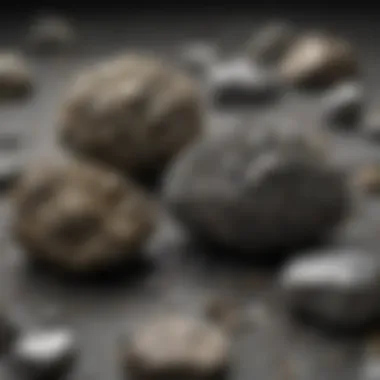
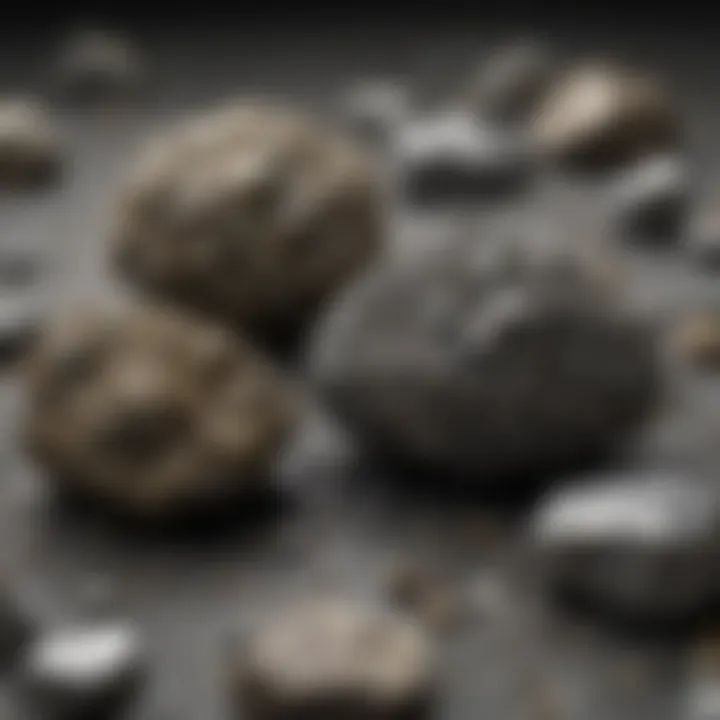
Importantly, marcasite can also occur as a result of hydrothermal processes. This is when hot mineral-rich waters seep through rock formations, depositing marcasite in fractures and cavities. Understanding these origins is crucial for collectors. It can help them determine the provenance of their specimens, thus affecting the commercial and display value.
Environmental Conditions Favoring Formation
Several environmental factors contribute to the formation of marcasite. These conditions include:
- Anaerobic Environments: Marcasite thrives in low-oxygen settings where iron and sulfur can easily combine. Such conditions are often found in stagnant waters.
- pH Levels: Acidic conditions can enhance the dissolution of iron-bearing minerals, increasing the availability of iron for marcasite synthesis.
- Temperature: Typically, marcasite crystallizes at lower temperatures compared to its counterpart pyrite. Therefore, cooler environments influence its formation more favorably.
"Deposits of marcasite can provide unique insights into past environmental conditions and geological processes."
Marcasites in Industry and Collecting
Marcasites hold significant value in various sectors, ranging from jewelry to geology. Their unique properties make them desirable for both practical applications and as collectibles. Understanding their role in these areas is essential for enthusiasts.
Applications in Jewelry and Decor
Marcasites are often incorporated into jewelry designs, adding an alluring quality to a wide range of items. Their unique luster and color can create striking contrasts with other materials like silver and gold. The most common forms found in jewelry include brooches, earrings, and pendants. Marcasite jewelry is often distinguished by a vintage aesthetic, appealing to collectors and casual wearers alike. It is essential to know that while these pieces are beautiful, they require proper care to preserve their appearance. Soft cloths are ideal for cleaning, while harsh chemicals should be strictly avoided to maintain their luster.
Use in Geological Research
From a scientific perspective, marcasites are valuable for geological studies. They are indicators of specific environmental conditions. Their formation often points to particular geochemical processes, which can inform researchers about historical climatic changes. Much of the ongoing research focuses on their role in sedimentary environments, providing insights into the Earth's geological history. Scientists analyze marcasite samples to understand other minerals and formations found within the same geological settings.
Value in Collecting Circles
In the realm of rock and mineral collections, marcasites have garnered interest due to their rarity and distinct characteristics. Collectors appreciate not only their unique formation but also their historical significance. Well-preserved specimens can fetch high prices, making them noteworthy for serious collectors. Some collectors focus on acquiring specimens with unusual crystal formations or colorations. Additionally, marcasite's use in various cultural artifacts enhances its appeal, attracting those who are interested in cultural history and mining heritage.
Collecting marcasites is not just a hobby; it is a connection to Earth's history and human craftsmanship.
In summary, the applications of marcasites extend beyond physical beauty and delight; they play critical roles in industrial practices and geological research. For collectors, their distinctive features and historical importance amplify their desirability.
Care and Preservation of Marcasites
Marcasites, though beautiful and intriguing, require careful maintenance to retain their luster and structural integrity. Proper care and preservation methods are essential for collectors to enjoy the aesthetic and geological significance of these minerals for years to come. Understanding how to maintain marcasites involves knowledge about cleaning, storage, and environmental factors. By emphasizing these elements, collectors can preserve their specimens in optimal condition, mitigating damage and ensuring long-lasting beauty.
Cleaning Techniques
Cleaning marcasites is a delicate process due to their susceptibility to damage from harsh chemicals and abrasives. Here are effective methods for cleaning these minerals:
- Gentle Brush Cleaning: Use a soft-bristle brush, such as a paintbrush, to carefully remove dust and debris from the surface. This prevents scratches and maintains the mineral’s finish.
- Soaking in Warm Water: A mild soap solution can be used if deeper cleaning is required. Soak the specimens in warm, soapy water for a few minutes, then gently scrub with a soft brush. Rinse thoroughly to remove any soap residue.
- Avoid Harsh Chemicals: Strong acids or abrasive cleaners can cause discoloration and pitting. It is best to avoid using these products entirely.
- Drying Properly: After cleaning, ensure that your marcasites are dried completely. Any moisture left on the surface can lead to oxidation, impacting their appearance.


Storage Recommendations
Proper storage is crucial for preserving the condition of marcasites. Here are some tailored recommendations:
- Avoid Direct Sunlight: Marcasites should be kept in a location away from direct sunlight, which can fade their color over time.
- Climate Control: Store your specimens in a stable environment where temperature and humidity are controlled to prevent tarnishing or deterioration.
- Use Acid-Free Materials: When displaying or storing, utilize acid-free boxes or containers to avoid chemical reactions that can damage the minerals.
- Individual Wrapping: Wrap each piece carefully in soft, lint-free cloth to prevent scratches or chipping when stored together.
- Display Cases: If exhibiting your marcasites, opt for display cases that limit exposure to dust and pollutants. These can include glass-front cabinets or shadow boxes that offer protection while allowing visibility.
By adhering to these care and preservation techniques, collectors can enjoy their marcasites in excellent condition, maintaining the value and beauty of these unique specimens.
Historical Significance of Marcasites
The historical significance of marcasites reveals much about humanity's relationship with minerals and their multifaceted roles in various cultures. Marcasite, although sometimes confused with pyrite, has a distinct identity and has been utilized in numerous ways throughout history. Its unique characteristics influenced both cultural practices and practical applications.
Cultural References and Symbolism
Marcasite has fascinated people for centuries, finding its way into various cultural narratives and symbolic uses. In the medieval ages, it was often linked with protection and prosperity. Ancient civilizations believed that wearing marcasite could shield the wearer from negative energies and bring good luck. This led to its incorporation into jewelry designs, especially in the form of ornate brooches, rings, and pendants.
In many societies, particularly in Europe, marcasite was celebrated for its resemblance to diamonds. Its reflective, metallic luster made it a prized material in ornamental pieces. Crafted jewelry often conveyed a sense of status and refinement, further embedding marcasite within cultural motifs of elegance and beauty.
Over time, marcasite has appeared in literature and folklore, where it symbolizes strength and resilience. This deep-rooted connection to human experiences has cemented its importance beyond mere physical properties, making it a significant cultural artifact.
Historical Uses and Discoveries
Historically, marcasite has been used for various purposes that showcase its versatility. One prominent application is in the field of adornments. From the 19th century onward, marcasite gained popularity as an affordable alternative to more expensive gemstones. Its low cost and availability made it especially popular among the working class, leading to a vibrant market for marcasite jewelry that is still appreciated by collectors today.
Moreover, marcasite has held scientific significance within geological studies. Recognizing its role in sedimentary deposits has provided insights into environments and conditions during its formation. Some notable discoveries include large marcasite formations in regions like the Appalachian Mountains and parts of the Midwest.
As research on sulfur-containing minerals expanded, the study of marcasite grew, revealing its importance in biogeochemical cycles, particularly in relation to sulfur's role in marine and terrestrial ecosystems.
Marcasite continues to be an intriguing subject for both collectors and researchers, reflecting its historical and ongoing significance in various fields.
Current Research and Innovations
Research on marcasites is evolving, revealing new insights into their geological and technological applications. This is vital for multiple sectors, from geology to engineering. Understanding the latest discoveries and innovations helps collectors appreciate marcasites beyond their aesthetic value. The findings can enhance practical applications, paving the way for advanced utilization of these minerals.
Recent Discoveries in Geological Studies
Recent geological research has targeted marcasites for their role in environmental conditions and biogeochemical cycles. Scientists have uncovered evidence of how marcasites can indicate paleoenvironmental conditions. For instance, a recent study highlighted that certain marcasite formations are linked to specific ancient environments, giving clues to past climatic changes. This outcome can aid in understanding Earth's geologic history more comprehensively.
Moreover, the discovery of marcasite deposits in various geographical locations sheds light on their formation processes. Some studies have utilized advanced imaging techniques to explore the microstructure of marcasite crystals. By understanding these structures, researchers are improving their comprehension of mineral growth and transformation under varying pressure and temperature conditions.
Innovative Uses in Modern Technology
Marcasites are finding innovative applications in contemporary technology. One notable area is in energy storage and conversion materials. Due to their unique chemical and physical properties, marcasites may be used as a key component in batteries and fuel cells. Their effective conductivity and stability make them attractive for energy applications. Researchers are exploring how modifying marcasite structures can further optimize these properties for better performance.
Another promising avenue is in nanotechnology. Marcasite nanomaterials present unique attributes, making them useful in biomedical applications. Some studies have shown potential in drug delivery systems, leveraging the mineral's properties to improve the efficiency of transporting medications inside the body. These findings could revolutionize medical treatments, providing a robust framework for developing advanced therapeutic methods.
"Marcasite research is not just limited to geology anymore; it is penetrating fields like energy and nanotechnology, indicating its versatile nature."



